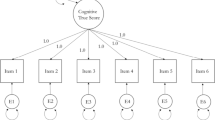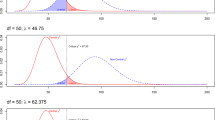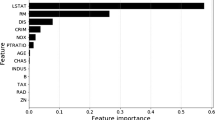Abstract
The partial credit model is considered under the assumption of a certain linear decomposition of the item × category parametersδ ih into “basic parameters”α j. This model is referred to as the “linear partial credit model”. A conditional maximum likelihood algorithm for estimation of theα j is presented, based on (a) recurrences for the combinatorial functions involved, and (b) using a “quasi-Newton” approach, the so-called Broyden-Fletcher-Goldfarb-Shanno (BFGS) method; (a) guarantees numerically stable results, (b) avoids the direct computation of the Hesse matrix, yet produces a sequence of certain positive definite matricesB k ,k=1, 2, ..., converging to the asymptotic variance-covariance matrix of the\(\hat \alpha _j \). The practicality of these numerical methods is demonstrated both by means of simulations and of an empirical application to the measurement of treatment effects in patients with psychosomatic disorders.
Similar content being viewed by others
References
Andersen, E. B. (1983). A general latent structure model for contingency table data. In H. Wainer & S. Messik (Eds.),Principals of modern psychological measurement (pp. 117–138). Hillsdale/NJ: Erlbaum.
Andrich, D. (1978a). A rating formulation for ordered response categories.Psychometrika, 43, 561–573.
Andrich, D. (1978b). Application of a psychometric rating model to ordered categories which are scored with successive integers.Applied Psychological Measurement, 2, 581–594.
Armijo, L. (1966). Minimization of functions having Lipschitz-continuous first partial derivatives.Pacific Journal of Mathematics, 16, 1–3.
Churchhouse, R. F. (1981).Handbook of applicable mathematics, Vol. III. Chichester—New York: J. Wiley.
Fischer, G. H. (1972). A measurement model for the effect of mass-media.Acta Psychologica, 36, 207–220.
Fischer, G. H. (1974).Einfürhrung in die Theorie psychologischer Tests [Introduction to mental test theory]. Bern: Huber. (In German)
Fischer, G. H. (1977). Some probabilistic models for the description of attitudinal and behavioral changes under the influence of mass communication. In W. F. Kempf & B. Repp (Eds.),Mathematical models for social psychology (pp. 102–151). Bern: Huber, and New York: Wiley.
Fischer, G. H. (1989). An IRT-based model for dichotomous longitudinal data.Psychometrika, 54, 599–624.
Fischer, G. H. (1991). A new methodology for the assessment of treatment effects.Evaluación Psicológical Psychological Assessment, 7, 117–147.
Fischer, G. H., & Allerup, P. (1968). Rechentechnische Fragen zu Raschs eindimensionalem Modell [Numerical problems in the unidimensional model of Rasch]. In G. H. Fischer (Ed.),Psychologische Test-theorie [Psychological test theory] (pp. 269–280). Bern: Huber. (In German)
Fischer, G. H., & Parzer, P. (1991a). An extension of the rating scale model with an application to the measurement of treatment effects.Psychometrika, 56, 637–651.
Fischer, G. H., & Parzer, P. (1991b). LRSM: Parameter estimation for the linear rating scale model.Applied Psychological Measurement, 15, 138.
Glas, C. A. W. (1989).Contributions to estimating and testing Rasch models. (Doctoral dissertation at the University of Twente, Department of Education). The Hague: CIP-Gegevens Koninklijke Bibliotheek.
Glas, C. A. W., & Verhelst, N. D. (1989). Extensions of the partial credit model.Psychometrika, 54, 635–659.
Gustafsson, J.-E. (1980). A solution of the conditional estimation problem for long tests in the Rasch model for dichotomous items.Educational and Psychological Measurement, 40, 377–385.
Jacobsen, M. (1989). Existence and unicity of MLEs in discrete exponential family distributions.Scandinavian Journal of Statistics, 16, 335–349.
Kosmol, P. (1989).methoden zur numerischen Behandlung nichtlinearer Gleichungen und Optimierungsaufgaben. Stuttgart: Teubner.
Masters, G. N. (1982). A Rasch model for partial credit scoring.Psychometrika, 47, 149–174.
Rasch, G. (1961). On general laws and the meaning of measurement in psychology.Proceedings of the IV. Berkeley symposium on mathematical statistics and probability, Vol. 4 (pp. 321–333). Berkeley: University of California Press.
Rasch, G. (1965).Statistisk seminar [Statistical seminar]. Cogenhague: University of Copenhague, Department of Mathematical Statistics. (Notes taken by J. Stene)
Rasch, G. (1967). An informal report on a theory of objectivity in comparisons. In L. J. Th. van der Kamp & C. A. J. Vlek (Eds.),Psychological measurement theory (pp. 1–19). Leyden: University of Leyden. (Proceedings of the NUFFIC international summer session in science in “Het Oude Hof”, The Hague, July 14–28, 1966).
Widowitz, E. (1987).Der Effekt autogenen Trainings bei funktionellen Erkrankungen. [The effect of “autogenous training” on the functional syndrome]. Unpublished master's thesis. Vienna: University Vienna, Department of Psychology.
Wright, B. D., & Masters, G. N. (1982).Rating scale analysis: Rasch measurement. Chicago: Mesa Press.
Zerssen, D. v. (1976).Klinische Selbstbeurteilungsskalen (KSb-S) aus dem Münchner Psychiatrischen Informations-System (PSYCHIS München) [The clinical self-rating scales (KSb-S) of the “Munich Psychiatric Information System” (PSYCHIS)]. Weinheim: Beltz.
Author information
Authors and Affiliations
Corresponding author
Additional information
The authors thank one anonymous reviewer for his constructive comments. Moreover, they thankfully acknowledge financial support by the Österreichische Nationalbank (Austrian National Bank) under Grant No. 3720.
Rights and permissions
About this article
Cite this article
Fischer, G.H., Ponocny, I. An extension of the partial credit model with an application to the measurement of change. Psychometrika 59, 177–192 (1994). https://doi.org/10.1007/BF02295182
Received:
Revised:
Issue Date:
DOI: https://doi.org/10.1007/BF02295182




